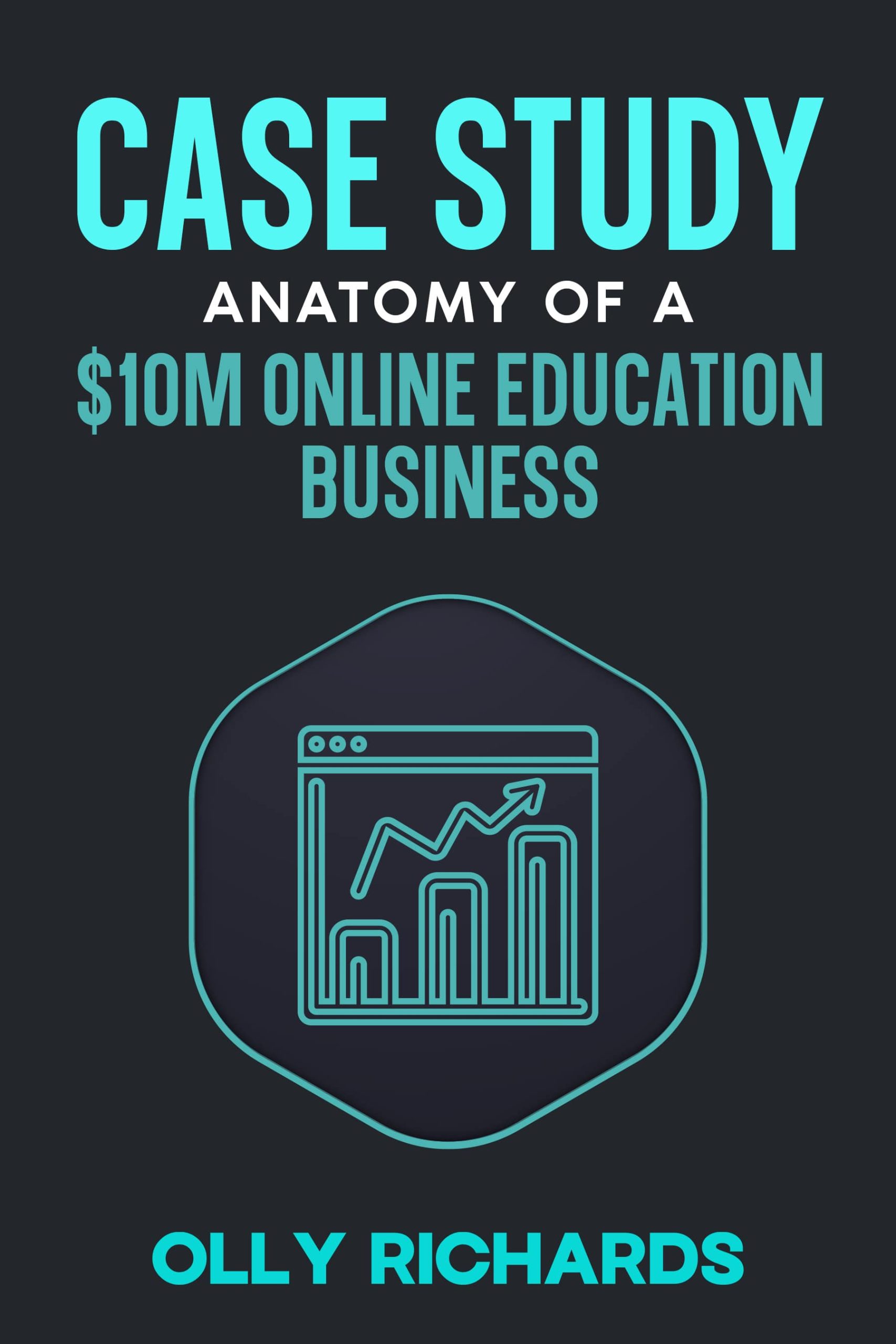From: Olly Richards
10th March 2023
Hobbitshire (10 yards down from a flock of sheep)
One of the little secrets of business is this:
The longer you’re in business, the easier it gets.
Right now, I’m sitting in my conservatory, looking out over my garden that’s just about to erupt into bloom, contemplating whether to go flying this afternoon or not.
The sun is strong. The cloud light.
It’s looking good.
And if I’m going to stand a chance of getting my Private Pilot License this year, I’m going to have to put in the hours.
(Did I mention it’s Monday morning?)

But it wasn’t always this way.
Just a few years back, Monday mornings for me were pretty damn hectic.
Every morning was hectic.
Writing blog posts, filming YouTube videos, writing copy for the next launch…
It was go-go-go.
Business life was like a sadistic game of whack-a-mole, with an eternal to-do list growing faster than a weed.
Everything felt hard.
And no matter what I did, growth was a slog.
But, slowly, that all began to change.
Our website traffic passed 1 million hits a month…
Our YouTube started gaining 10,000s subscribers a month…
And, our high-ticket certifications started selling out so fast we had to turn people away! (Without so much as a single dollar spent on ads.)
The longer you’re in business, the easier it gets.
In moments of hubris, I’ll think:
“Well, it’s because we’re great at what we do!”
But then when I think a little deeper, I’ll realize…
“It’s all down to the Flywheel Effect!”
But what is this mysterious flywheel of which I speak?
Read on…
This newsletter is all about the Flywheel Effect, and how you can use it to your advantage to create the kind of explosive results you read about in glossy magazines.
Or in pretentious newsletters 🙂
The Flywheel Effect
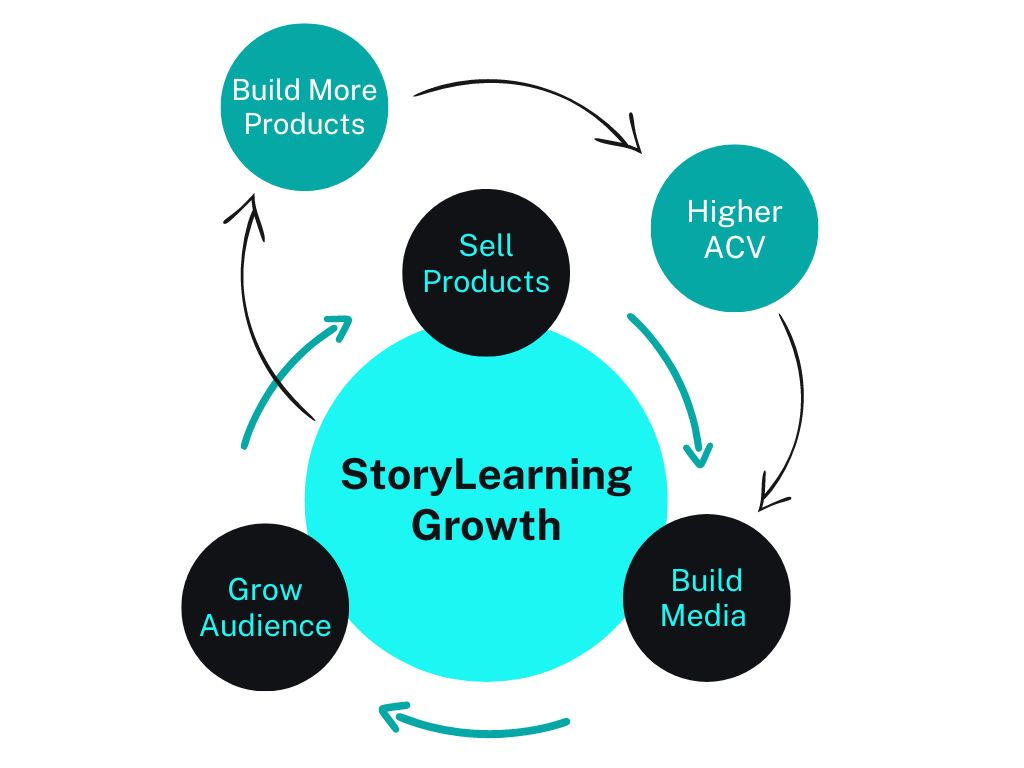
There’s a strange phenomenon I often see when talking to new founders:
The smarter the founder, the more they struggle.
Smart founders tend to look for shortcuts.
To outsmart the competition.
Growth hack their way to success.
Then, when they fail to become the next Mark Zuckerberg in their first 12 months, they get frustrated and switch to disparaging the competition instead.
“They’re only getting attention because the founder’s a hot chick!”
(Unfortunately, I’ve heard this kind of comment a lot.)
Founders experience this kind of dissonance where there’s a mismatch between:
- How smart they are, and
- How quickly they’re able to get results
Growth doesn’t give a s*** how smart you are.
Growth responds to momentum.
And the thing about momentum is…
Momentum takes time and patience.
The Flywheel Effect demonstrates how organic growth happens:
"There is no single defining action, no grand programme, no one killer innovation, no solitary lucky break, no miracle moment. Rather, the process resembles relentlessly pushing a giant, heavy flywheel, turn upon turn, building momentum until a point of breakthrough, and beyond." - Jim Collins
What this shows is that momentum doesn’t come from a few smart moves.
Rather, momentum comes from a self-reinforcing process.
When you execute on this process over and over, the impact snowballs.
Eventually, you create a unique force of nature with exponential growth.
The growth takes on its own dynamic, immune to “out-smarting”, shortcutting or otherwise ripping off.
For smart-ass founders, spending other people’s money, with investors breathing down their neck, this is bad news.
But for people of average intelligence (e.g. yours truly), spending their own money and happy to play the long game, it’s good news.
Because the longer you’re in business, the easier it gets.
What Is A Flywheel?

So, a flywheel is a self-reinforcing process that starts slow, but eventually creates breakout dynamics.
Let’s start with a relatable example.
Imagine you buy a rental property with a 25 year mortgage. Every month you collect your rent, make the interest payment and pocket the difference. Over time, your interest payments go down, and you keep more of the rent each month. After 25 years, you own the property and keep all the rent.
Simple.
However, there was an interesting rouse that we saw play out in the 1990s property market in the UK. With house prices rising 10-20% per year, people realized that they could buy a property, wait a year or two, and then release a bunch of equity. They would use this equity to buy a second property, then a third and fourth after that, and so on. The more properties they owned, the more capital they had access to.
People were able to benefit from 10-20% annual capital growth on multiple properties, as opposed to the single unit in the first scenario.
Those who timed their exit right, made millions.
To do this, you have to understand the core flywheel effect of the business model:
Releasing equity to buy more and more properties, thereby exponentially growing the value of your capital.
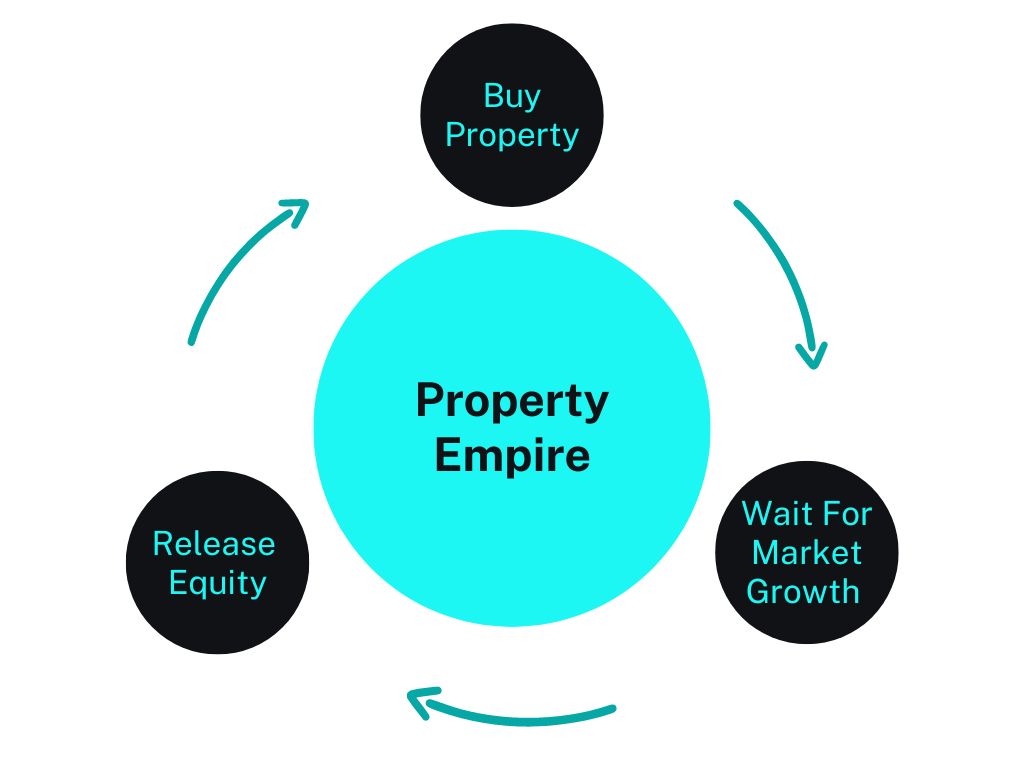
This example is easy to understand, but kinda reckless from a business perspective, because of the amount of exposure to market forces out of your control. (Rental demand, tax laws, access to capital.)
Let’s look at a more mainstream business example…
Amazon, and how they became the #1 online store.
Amazon’s core plan was to offer the most stuff at the lowest prices. They believed that this would result in the best customer experience and ever more market share.
So far so simple.
Here’s where the flywheel came in:
When Amazon made profit, they ploughed that profit back into building infrastructure. This infrastructure resulted in a lower cost base, which allowed them to reduce prices even further.
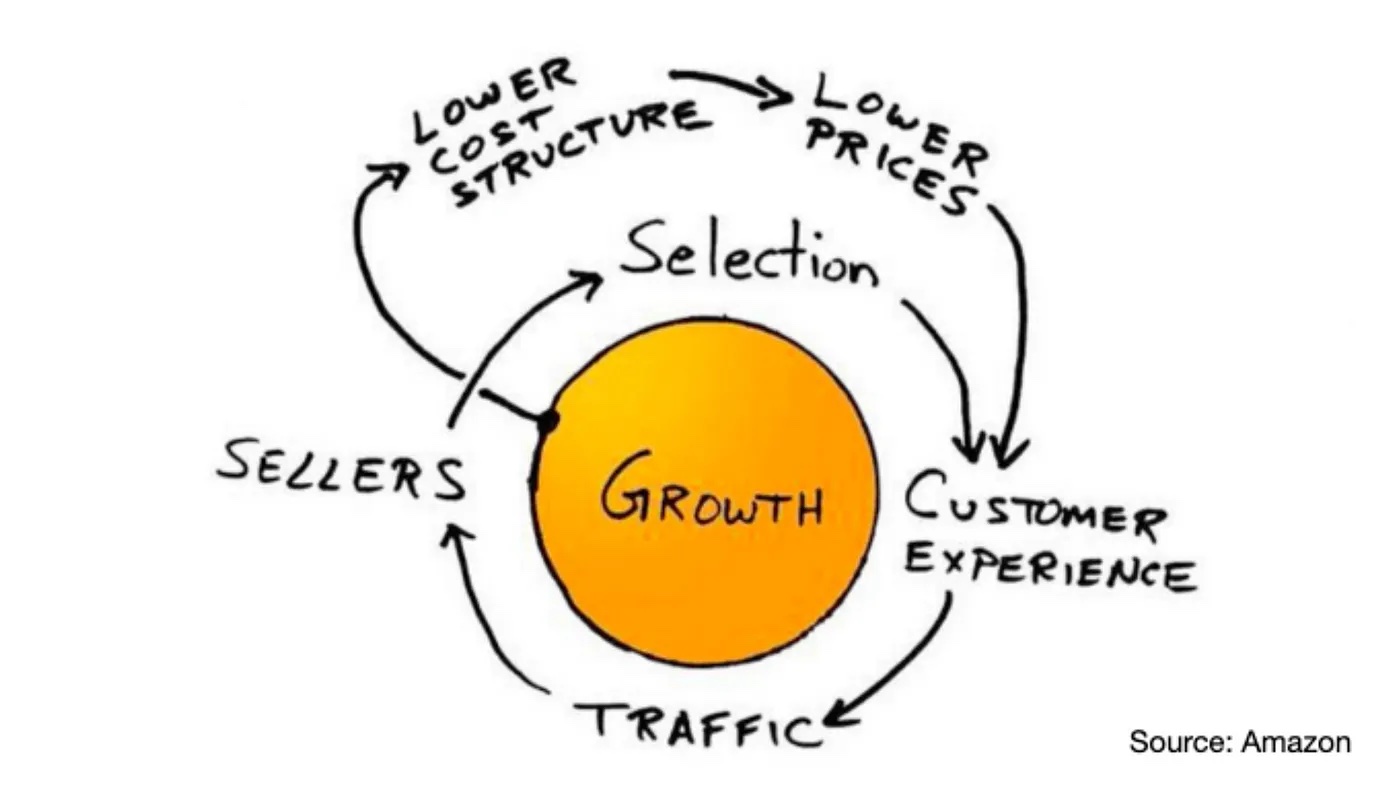
Over time, prices dropped so far that Amazon became the only choice for online consumers.
When Amazon owned all the customers, all sellers were forced to list on Amazon.
Over time, Amazon became impossible to compete with.
“The process resembles relentlessly pushing a giant, heavy flywheel, turn upon turn, building momentum until a point of breakthrough, and beyond.”
The Flywheel for an Online Education Business
In both examples, the flywheels worked because they grew the core business model:
- Property - acquiring as many units as possible
- Amazon - creating the best customer experience possible
Over at StoryLearning, our core business model is:
- Build audience via content
- Sell products to that audience
The better content we create, the more audience we grow.
The more audience we grow, the more money we make with our paid offerings.
Critically…
The money we make gets ploughed back into content and audience.
As the profit grows, we make more products. These new products create more cash, which…
You guessed it…
Gets ploughed right back into audience growth.
And this is what creates the flywheel of growth that compounds on itself and become unstoppable over time.

When you relate this to a competitive advantage, this is where it gets interesting.
For Amazon, the net result was that they were able to drive costs for the customer lower than anyone else.
For us at StoryLearning, we’ve been able to build such a large digital footprint, that we give the impression of “being everywhere”, and it’s growing all the time, which makes it very difficult for upcoming competitors to even begin to tackle.
It’s common for someone to buy one of my books from Barnes & Noble, get served a YouTube video the next day, find my website in a Google search the day after that, and then get recommended one of our programmes by a friend.
This is a powerful effect that comes from a (very deliberate) flywheel operation.
It takes time.
It takes clarity.
And it takes commitment.
The longer you’re in business, the easier it gets.
Isn’t It Obvious How To Grow? (Spoiler: No!)
There’s a sense in which this might all sound obvious…
“Just invest in what works!”
Trouble is, flywheels take time to grow.
Everything is obvious in hindsight…
But when you’re early-stage, you can easily put money into all the right things without seeing any payoff for years.
Take SEO content, for example.
It takes years to grow your site to an age and authority where Google prioritises you in search.
And only then does the content you spent years writing really kick in, creating the kind of crazy compounding that I showed you in the case study:
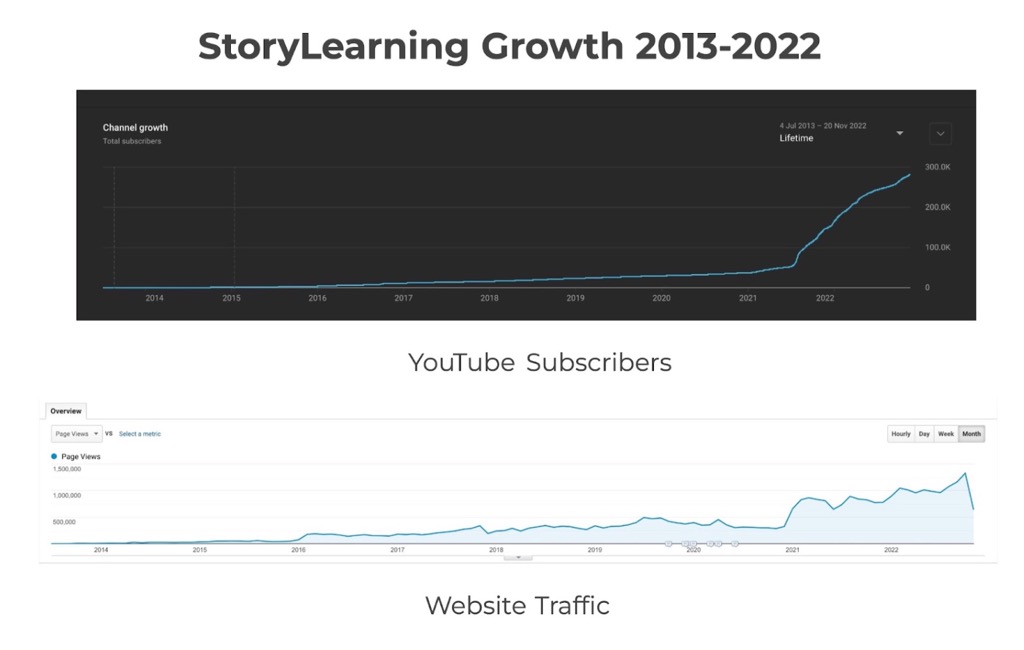
And now that we’re in the fortunate position of having so much traffic to play with, do we sit back and sip martinis on the beach?
Hell, no.
It all goes straight back into new media properties - YouTube channels, paid ads… audience growth of all descriptions.
Because I know that our flywheel relies on growing new audience. Stopping audience growth is akin to killing future growth.
Back to Amazon again…
Amazon’s model sounds obvious in hindsight.
“Just build the biggest selection with the cheapest cost!”
But put yourself in Bezos’ shoes in the late '90s…
Imagine how many billions of dollars was needed to build the infrastructure that gave Amazon its economies of scale.
You can be sure Bezos faced significant opposition at every step of the way.
“We should take some profit, Jeff…”
But it was his fundamental belief in the Amazon flywheel that created the eventual world domination.
How To Reinvest Confidently Into Your Business
To recap:
“There is no single defining action, no grand programme, no one killer innovation, no solitary lucky break, no miracle moment. Rather, the process resembles relentlessly pushing a giant, heavy flywheel, turn upon turn, building momentum until a point of breakthrough, and beyond.”
And so, the real power the flywheel is that it removes doubt over that big question: “How should I reinvest in the business?”
When you’re clear on your core business model flywheel, there’s never any doubt…
You know exactly where to put every single dollar of profit.
Because even when it feels like money is only flowing in one direction (i.e. out!)…
You understand that all you’re doing is slowly pushing that giant, heavy flywheel, and that every day you’re getting a step closer to that explosive growth you read about in those magazines.
(As someone said the other day when talking about StoryLearning: “The 10 year overnight success story.”)
So, what’s the flywheel in your business?
Here are some questions to think about:
- What is the “lifeblood” of your business? (Your first reaction is probably the right one)*
- What is the biggest competitive advantage you would like to have?
- What unfair advantage do you have in your industry?
- What is the thing your customers value the most?
- What is something your competitors don’t do well?
- What is one thing you do that seems to make everything else easier?
- What is something that, if you focused relentlessly on it for 5 years, you could be world-class at?
Grab a piece of paper…
Do some sketching…
Sometimes these flywheels emerge organically when you’re playing around!
In reality, my guess is that you already kinda know what your flywheel is.
And it shouldn’t be complicated. (Amazon’s isn’t.)
The value of getting clear on your flywheel is that you get clarity of purpose, and the confidence to pursue it with mind, body and soul.
As for me…
The sun is still strong.
And the cloud light.
So, I’m going to give myself permission to enjoy the fruits of a 10-year flywheel, and head out to the airfield.
If you’d like to drop me a reply describing the flywheel in your business, I’d love to see it.
And make sure you’re following me in my two social medias of choice:
Go on… gimme a follow…
The flywheel for this newsletter isn’t going to kickstart itself! 😉
Namaste,
Olly
CASE STUDY: Blueprint Of A $10m Online Education Business:
Join my free newsletter for online educators and I'll send you the case study immediately...
We will protect your data in accordance with our data policy!
